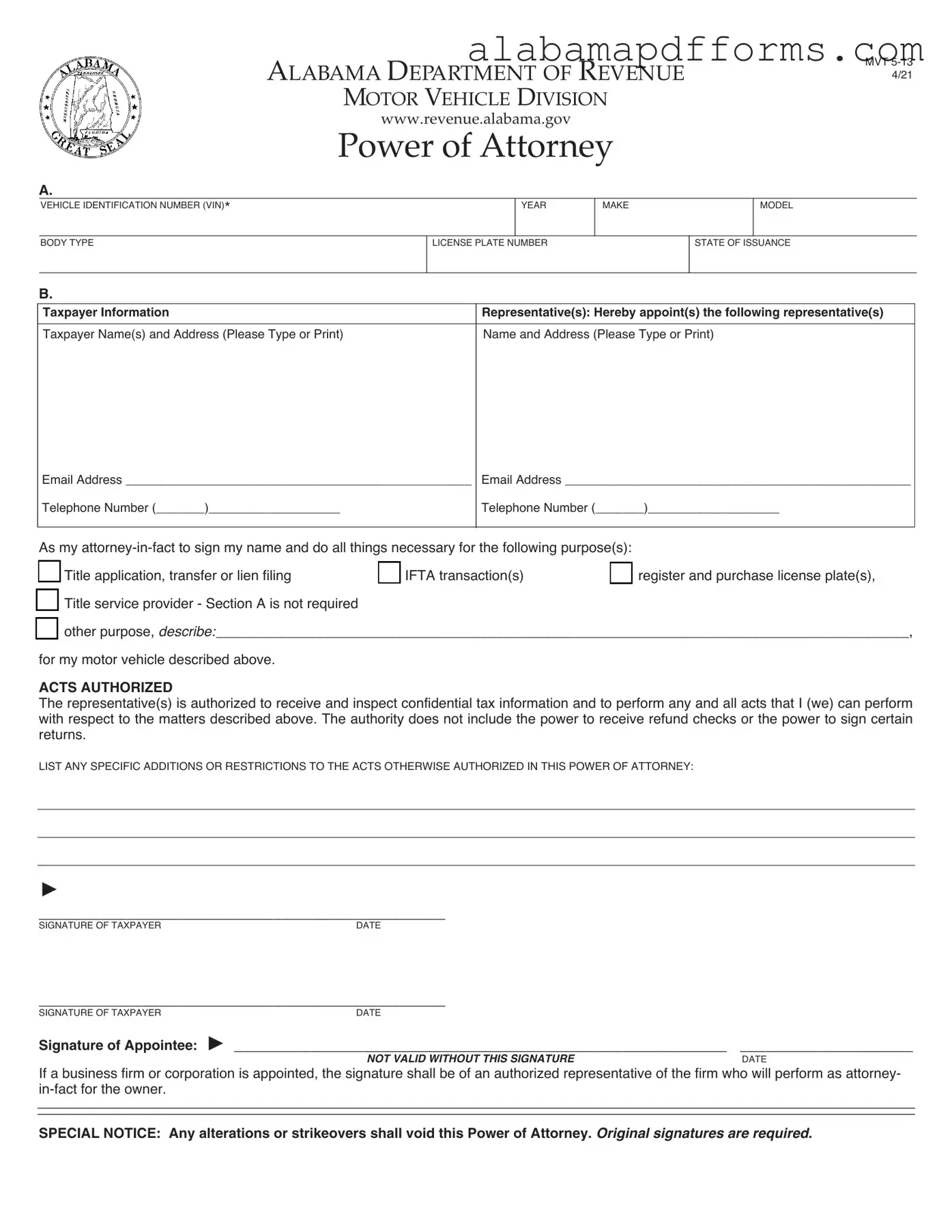The Alabama Vehicle Power of Attorney (POA) MVT 5-13 form allows an individual to authorize another person to act on their behalf regarding vehicle-related matters. Similar to this form is the General Power of Attorney. This document grants broad powers to an agent, allowing them to manage various affairs, including financial transactions, real estate, and personal matters. Both documents require the principal's signature and are designed to facilitate decision-making by a trusted individual.
Another similar document is the Limited Power of Attorney. This form provides specific powers to the agent for a defined purpose, such as handling a vehicle sale or registration. Unlike the Alabama Vehicle POA, which is tailored for vehicle-related issues, the Limited Power of Attorney can cover various areas, but it still requires clear definitions of the agent's authority.
The Vehicle Title Transfer form is also comparable. This document is used when ownership of a vehicle changes hands. It requires signatures from both the seller and the buyer, similar to how the Alabama Vehicle POA requires the principal's signature. Both documents aim to ensure that the transfer of rights and responsibilities regarding a vehicle is documented properly.
In addition to the aforementioned forms, it is essential for motorcycle transactions to include proper documentation as well, such as the Motorcycle Bill of Sale form, which provides a legal record of the ownership transfer and protects both parties involved in the sale.
Additionally, the Bill of Sale serves a similar purpose in documenting the sale of a vehicle. This document outlines the details of the transaction, including the buyer, seller, and vehicle information. Like the Alabama Vehicle POA, it is crucial for establishing legal ownership and protecting the interests of both parties involved in the transaction.
The Release of Liability form is another document that shares similarities. When a vehicle is sold, the seller can use this form to notify the Department of Motor Vehicles that they are no longer responsible for the vehicle. This document provides protection for the seller, similar to how the Alabama Vehicle POA protects the interests of the principal by allowing someone else to manage their vehicle-related tasks.
The Application for a Duplicate Title is also relevant. If a vehicle title is lost or damaged, this form allows the owner to request a replacement. While it does not grant authority to another person, it is part of the vehicle ownership process, much like the Alabama Vehicle POA, which facilitates ownership management.
The Affidavit of Heirship for a Vehicle can be compared as well. This document is used to establish ownership of a vehicle when the original owner has passed away. It allows heirs to claim the vehicle without going through probate. Both the Affidavit and the Alabama Vehicle POA deal with the transfer and management of vehicle ownership but in different contexts.
Another similar document is the Vehicle Registration Application. This form is necessary for registering a vehicle in the owner's name. It requires information about the vehicle and the owner, similar to how the Alabama Vehicle POA requires details about the principal and the agent authorized to act on their behalf.
The Consent for Minor to Drive form is also noteworthy. This document allows a parent or guardian to grant permission for a minor to operate a vehicle. While it serves a different purpose, both this form and the Alabama Vehicle POA involve the delegation of authority regarding vehicle use and management.
Lastly, the Vehicle Inspection Report can be considered similar. This document is used to certify that a vehicle meets safety and emissions standards. While it does not involve the transfer of authority, it is an essential part of vehicle ownership and management, akin to the responsibilities outlined in the Alabama Vehicle POA.

